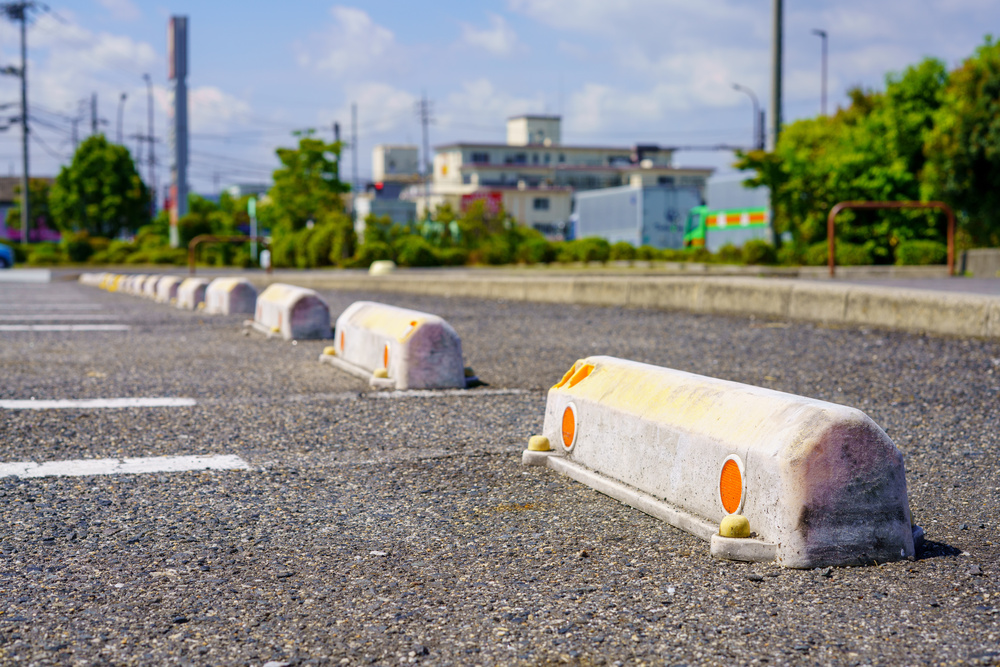Wheel stops are those small barriers at the end of parking spaces that stop your car’s tires as you drive forward or backward to park. It’s designed to assist drivers with parking their vehicles properly. These stops are also known as curb stops or parking blocks. These stops may benefit drivers, but they’re consistently identified as pedestrian tripping hazards.
Wheel stops are usually fitted along perimeters or fence lines to prevent cars from blocking pedestrian walkways and interfering with traffic flow. They’re intended to prevent pedestrians from being involved in accidents with vehicles and from being injured by those vehicles.
The make, color, size, and material of these stops vary. You can find them in auto supply shops in your locality, or you can find them online. Find the best page where you can scan through the type and kind of curb stops you have in mind.
Manufacturers now make wheel stops from various materials, including concrete, metal, polyethylene, and rubber. Over the years, wheel stoppers have been a piece of equipment utilized for managing, controlling, and calming traffic, including pedestrian safety. This concept has been extended not only to controlling traffic flow and protecting pedestrians but also to protecting car tires.
That’s why garage owners choose tire stop material appropriate for their car or truck’s tires. They usually make preferences over rubber, or concrete wheel stops. It’s just one of those ways of protecting tires from damage. Any of these tire impairments can be one of the causes of truck accidents.
But taking time to choose between a concrete tire stop over its rubber counterpart has advantages and disadvantages. Finding time to browse these points may help you find the best curve stop for your garage or perimeter fence.

The Pros And Cons Of Using Rubber Or Concrete Wheel Stops
- The Cost vs. Beneficial Use
One of the advantages of the concrete wheel stop is its cost. It’s cheaper if compared with the rubber tire stopper. Rubber wheel stops are more expensive to produce due to the processing and manufacturing involved. Unlike the cement used in concrete tire stops, which is readily available, rubber tires are made from recycled tires.
The concrete curb blocks may be cheaper than the ones made of rubber, but it’s disadvantageous for your tires. It’ll not bounce but give a loud thud depending on the force of the impact when you’re in a hurry to park. This constant impact will contribute to the wear and tear of your tires. It’s self-evident to see if your tires are old and need replacement.
The primary constraint on a rubber-made stopper may be its price. But one of its pros is the durability of rubber material. Rubber is not prone to wear and tear brought about by the hazards of the environment. It’ll help protect your tires for a long time.
- Ease Of Use vs. Length Of Use
Concrete wheel stops made of concrete can be installed either inside or outside of a building. Concrete wheel stops are so much heavier than those made of other materials. It’s one of the material’s significant advantages. Because of this, tire stops made of concrete are stable once securely installed. They would do an excellent job of preventing vehicles from going to parking areas not designated for them.
In addition, concrete barriers have the potential to be very long-lasting and durable, mainly when they are installed indoors. Or they’re positioned in areas shielded from the effects of the external environment.
However, one of the most significant drawbacks of using concrete wheel stops is that they tend to deteriorate over time if installed in an outdoor setting. Especially if they are regularly subjected to the sun, rain, snow, and other natural wear and tear forms. The constant impact of vehicle wheels can also cause the concrete wheel stops to be chipped and cracked, especially if they’re saturated by water or weakened.
On the other hand, rubber wheel stops are resistant to the elements and are unaffected by snow, high temperatures, or low temperatures. They also establish a secure grip with the wheels and contribute to the control of the steering wheel’s stability. Wheel stops made of rubber are also resistant to oil, chemicals, and UV light. These rubber-made tire stops work just as well indoors as outdoors, in areas where cars, bicycles, trucks, and other light-duty and heavy-duty vehicles pass one another.
Due to these factors, the price of rubber wheel stops is higher than the concrete tire stops. But it’s reasonable considering the quality of these products. Rubber wheel stops have a longer life than concrete ones. They’re extraordinarily long-lasting and can be used indoors or outdoors without the user needing to be concerned about the stoppers being subjected to heavy use. Its high cost will be compensated for the length of its beneficial use.
- Custom-Made vs. Mass-Produced
Tire stop products that promote driver safety on the road should have bold colors and high visibility. Some wheel stops are entirely colored, while others have reflective strips or markings to make them visible even in dim light. The varieties of wheel stops can be distinguished by their appearance.
Rubber wheel stops offer several benefits. One of the most notable is that they can be custom-made or pre-cast with reflective tape or have molded colors that do not fade over time. Natural elements and moisture are unable to affect their color. You won’t have any trouble using these rubber tire stops in particularly hot or humid areas.
Concrete wheel stoppers are easily mass-produced. They’re molded and made first before their exteriors are painted in various colors. When the paint is new, they have a clean appearance and are easy to see. However, their color will fade once you install them on the road, where they will be subjected to the direct impact of wheel traffic and variable weather. You can either shell out additional cash to have those wheel stops repainted or use wheel stops with fading color, both of which are risky.
- D-I-Y Or Installation Services
One of the primary elements that should be considered when selecting suitable wheel stops for your vehicle is how the wheel stops are made and installed. You need to look for wheel stops with an easy installation process so you can do it yourself. Hiring installation services will add to your costs. Parking lots that need to have several wheel stops installed can be a time-consuming process. Additionally, heavy machinery may be required to ship, deliver, and install the wheel stops. All these installation arrangements may increase your costs and deplete your funds.
Another disadvantage of concrete wheel stoppers is their weight. You ought to know that concrete and metal tire stops are heavy and usually take anywhere from two to three people to move or install them. It’s not easy to install these concrete tire stoppers on your own. Hiring installation services will be a costly but necessary option.
On the other hand, rubber wheel stoppers are incredibly lightweight. A single person can easily install them in a matter of minutes. You can do it on your own and save on the installation costs. You can find easy installation guides online to help you with your D-I-Y project.
Bottom Line
Whether you’ll have concrete or rubber tire stoppers for your parking space depends on your assessment of the immediate or long-term financial effect. It also depends on whether your vehicle’s tires need rubber or concrete specifications.
Feel free to search the links in this content and see the advantages and disadvantages of rubber and concrete wheel stops.




